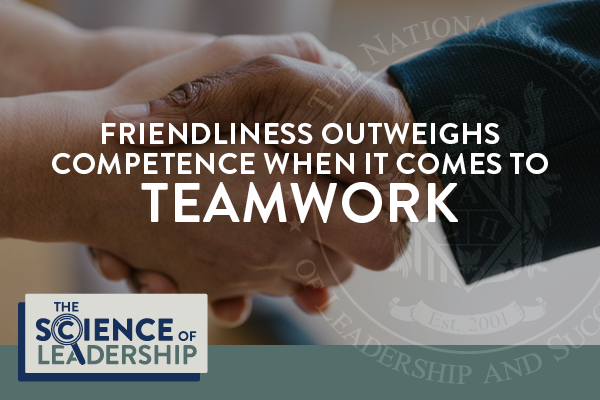Everyone has a unique leadership style, ranging from democratic to autocratic, servant to laissez-faire, and a bunch of other styles in between.
Typically, discussions around leadership styles have focused on how well various styles inspire their teams and achieve goals, but a new study takes aim at a different aspect: health.
This week in The Science of Leadership, we examine recent research that suggests leadership styles can have a direct impact on team health and well-being even if the leader doesn’t realize it.
The Study: Leadership and Employee Health
In a new paper published in Sport Management Review, a team of researchers led by Steve Swanson from Deakin University in Australia set out to shine a light on personal well-being when it came to employees in the sporting industry, an area that the team believed was understudied. They also say that their findings apply broadly, despite only looking into one industry.
After collecting and analyzing data from nearly 500 business operations workers, the team came to a conclusion: managers often focus on one area of employee well-being while ignoring others.
For example, many managers and leaders focus on providing their teams the ability to perform meaningful work and the chance to take on more responsibilities; however, managers tend to ignore drawbacks associated with this approach, including how increasing workloads can lead to burnout.
“The three main facets of employee well-being we discovered in our research centered around employees' social, psychological, and physical needs,” Swanson reports.
“If an employer focuses too much on creating meaningful work and providing their staff with opportunities to take on extra responsibility, we’ll see two things happen. Employees' psychological well-being may be boosted because they feel challenged and that they are building their skillset. On the other hand, these employees are often more prone to experiencing setbacks in social and physical health.”
The researchers coined this as “managerial trade-offs.” In short, this means that managers and leaders do not look at their team members’ needs holistically. Instead, they focus on one area and never examine the bigger picture.
Solving the Burnout Problem

So, how do we get from managerial trade-offs to actual physical health?
By performing managerial trade-offs, the team found that people can move up in their careers and also keep performing meaningful work, but they may be adversely impacted by burnout, which is a form of exhaustion characterized by being overwhelmed and overworked.
As the World Health Organization (WHO) puts it:
“Burnout is a syndrome conceptualized as resulting from chronic workplace stress that has not been successfully managed. It is characterized by three dimensions: feelings of energy depletion or exhaustion; increased mental distance from one’s job or feelings of negativism or cynicism related to one's job; and reduced professional efficacy.”
Burnout has been making headlines as the condition becomes more prevalent. According to a 2021 study of 1,501 workers by the American Psychological Association, 79 percent reported having workplace stress.
In a similar study by Indeed that also looked at 1,500 US workers, the researchers found that over half of all participants experienced burnout in 2021, with millennials reporting the highest amounts (59 percent), followed by Gen Z right behind them (58 percent).
With so many people burning out, researchers have examined how the condition impacts real-world health. According to the Mayo Clinic, unaddressed burnout can lead to major health problems, including:
- Excessive stress
- Fatigue
- Insomnia
- Sadness, anger, or irritability
- Alcohol or substance misuse
- Heart disease
- High blood pressure
- Type 2 diabetes
- Vulnerability to illnesses
This shows a clear connection between how leaders operate and the actual, physical health of employees or teams. According to the newly published paper, this very real-world connection has often gone overlooked, which needs to change.
The Impact of Your Leadership Style
What’s the solution? If what the new study suggests is correct and managers are inadvertently creating burnout conditions, is there anything they can do to put a stop to it?
In short, yes, but it all comes down to how leaders actually lead. In their study, the team calls the methods most leaders take “traditional” style leadership. However, they do not go into exactly what “traditional” entirely means.
Likely, a traditional leader values their team, pushes them to succeed, and hopes they’re engaged and fulfilled, but is also one who may not look at the full picture and make trade-offs that could be detrimental.
The team clearly identified a style that takes the complete picture into account, which is servant leadership.
“Servant leadership is a style based on the desire to give to your community. By putting the needs of others first, you empower people to perform at their best. When members of the community see your passion and commitment through your actions, they want to be connected to you,” writes Bethany VanBenschoten in an overview of the style.
This type of leadership utilizes the holistic approach to leadership that the research team suggests that other “traditional” leaders lack. Instead of just trying to get a team member to succeed or improve, servant leaders look at the entire person, and it’s their goal to ensure that the team member is happy, healthy, and thriving.
“Research into leadership and employee satisfaction has, until now, failed to recognize that people aren't one-dimensional. They have well-being needs across different areas that managers must cater to,” Swanson writes.
“Employee well-being is holistic, and the sooner employers recognize that, the sooner they can start creating a better work environment where employees feel challenged, but also valued and supported in all areas.”

Though the team suggests that servant leaders are the most equipped for increasing team-member wellness, everyone’s leadership journey is unique and styles are often blended together.
The real takeaway here is that leaders need to look within themselves to understand their strengths and weaknesses better. This starts by understanding what leadership style you naturally fall into.
With a baseline understanding, you can begin to hone your methods further by incorporating aspects of other styles into how you lead. In other words, if you find that you align more with a democratic style of leadership, that doesn’t mean you have a worse style than a servant leader. You always have the chance to fill in gaps or borrow from other techniques.
Another key takeaway from the new research is that leaders simply need to be more aware. They need to know the signs of burnout and remember that people are unique and require different types of support, but that all starts with making a conscious decision to pay closer attention.
The Science of Leadership connects cutting-edge leadership research to the real world.
Ready to dig deeper? Read the team’s full paper. Also, explore all different types of leadership styles and read our complete overview on servant leadership and transformational leadership.
Have a burning question about any of the topics we’ve covered? Email us at blog@nsls.org. We’d love to hear from you.




